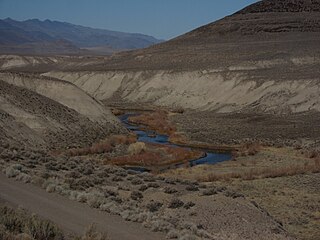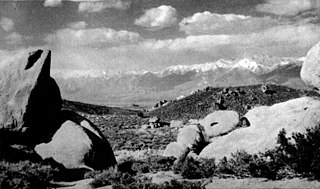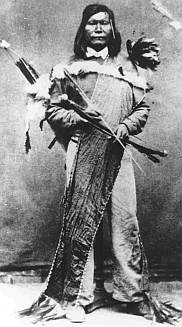
The Pony Express was an American express mail service that used relays of horse-mounted riders. It operated from April 3, 1860, to October 26, 1861, between Missouri and California. It was operated by the Central Overland California and Pikes Peak Express Company.

Sarah Winnemucca Hopkins was a Northern Paiute author, activist (lecturer) and educator. Her maiden name is Winnemucca.

Ormsby County was a county in Nevada Territory from 1861 to 1864 and in the State of Nevada from 1864 until 1969. It contained Carson City, the county seat, and later, the state capital, founded two years earlier.

The Northern Paiute people are a Numic tribe that has traditionally lived in the Great Basin region of the United States in what is now eastern California, western Nevada, and southeast Oregon. The Northern Paiutes' pre-contact lifestyle was well adapted to the harsh desert environment in which they lived. Each tribe or band occupied a specific territory, generally centered on a lake or wetland that supplied fish and waterfowl. Communal hunt drives, which often involved neighboring bands, would take rabbits and pronghorn from surrounding areas. Individuals and families appear to have moved freely among the bands.

The Truckee River is a river in the U.S. states of California and Nevada. The river flows northeasterly and is 121 miles (195 km) long. The Truckee is the sole outlet of Lake Tahoe and drains part of the high Sierra Nevada, emptying into Pyramid Lake in the Great Basin. Its waters are an important source of irrigation along its valley and adjacent valleys.

The Carson River is a northwestern Nevada river that empties into the Carson Sink, an endorheic basin. The main stem of the river is 131 miles (211 km) long although the addition of the East Fork makes the total length 205 miles (330 km), traversing five counties: Alpine County in California and Douglas, Storey, Lyon, and Churchill Counties in Nevada, as well as the Consolidated Municipality of Carson City, Nevada. The river is named for Kit Carson, who guided John C. Frémont's expedition westward up the Carson Valley and across Carson Pass in winter, 1844. The river made the National Priorities List (NPL) on October 30, 1990 as the Carson River Mercury Superfund site (CRMS) due to investigations that showed trace amounts of mercury in the wildlife and watershed sediments.
The Snake War (1864–1868) was an irregular war fought by the United States of America against the "Snake Indians," the settlers' term for Northern Paiute, Bannock and Western Shoshone bands who lived along the Snake River. Fighting took place in the states of Oregon, Nevada, and California, and in Idaho Territory. Total casualties from both sides of the conflict numbered 1,762 dead, wounded, or captured.

Winnemucca was a Northern Paiute war chief. He was born a Shoshone around 1820 in what would later become the Oregon Territory.

Fort Churchill State Historic Park is a state park of Nevada, United States, preserving the remains of a United States Army fort and a waystation on the Pony Express and Central Overland Routes dating back to the 1860s. The site is one end of the historic Fort Churchill and Sand Springs Toll Road. The park is in Lyon County south of the town of Silver Springs, on U.S. Route 95 Alternate, eight miles (13 km) south of U.S. Route 50. Fort Churchill was designated a National Historic Landmark in 1961. A 1994 park addition forms a corridor along the Carson River.
The 1st Nevada Cavalry Battalion, or the Nevada Territory Cavalry Volunteers, was a unit raised for the Union army during the American Civil War. It remained in the west, garrisoning frontier posts, protecting emigrant routes, and engaged in scouting duties. The unit was disbanded in July 1866.

The Second Battle of Pyramid Lake took place in response to the U.S. defeat at the First Battle of Pyramid Lake. A well-organized force of militia and regulars, under the capable leadership of famed Texas Ranger Col. John C. "Jack" Hays, defeated the Paiute warriors under Chief Numaga. This was the final engagement of the Pyramid Lake War of 1860.
The Battle of Williams Station was a minor skirmish during the Pyramid Lake War of 1860. The fight took place following the defeat of Major William Ormsby at the First Battle of Pyramid Lake as U.S. Volunteers entered the war.
Truckee, also known as Captain Truckee, Wuna Mucca, The Giver of Spiritual Gifts, Old Winnemucca, One Moccasin, Onennamucca, One-ah-mucca), or Old Chief Winnemucca, was a medicine chief of the Northern Paiute people and an influential prophet. How he gained the name Truckee is up for debate as different accounts credit different people/groups with giving Winnemucca the nickname. Chief Truckee led his people through a rapidly changing time in California history while also becoming one of the most respected chiefs both by his people and to an extent by the settlers who he often aided. For simplicity he will be referred to as Truckee or Old Winnemucca for the rest of the Article.

William Matthew Ormsby was an early settler of Nevada who was instrumental in the establishment of Carson City and the Nevada Territory. Major Ormsby was killed leading a Militia force against Paiute Indians in what was called the Pyramid Lake War.

The Owens Valley War was fought between 1862 and 1863 by the United States Army and American settlers against the Mono people and their Shoshone and Kawaiisu allies in the Owens Valley of California and the southwestern Nevada border region. The removal of a large number of the Owens River indigenous Californians to Fort Tejon in 1863 was considered the end of the war. Minor hostilities continued intermittently until 1867.
The Williams Station massacre was an incident that ignited the Pyramid Lake War of 1860.

Numaga was a Paiute leader during the Paiute War of 1860 that centered on Pyramid Lake in what is now Nevada in the United States. The war was caused by an influx of miners and ranchers after silver was discovered in the Comstock Lode near to Carson City. The newcomers assaulted the Paiutes and destroyed their foods supplies. When the Paiutes responded, the U.S. Army used force to suppress them. Both before and after the war, Numaga was a strong advocate of peace and did much to reduce the violence on both sides. He died of tuberculosis, a "white man's disease", in 1871.
The Battle of Mud Lake/Mud Lake Massacre, also known as the "Skirmish at Mud Lake", occurred on 14 March 1865 during the Snake War in northwest Nevada Territory, at present-day Winnemucca Lake, Nevada, during the closing months of the concurrent American Civil War.
Deep Hole is a ghost town in Washoe County, Nevada. Founded by Ladue Vary in 1856, Deep Hole is located southwest of the Granite Range in the Black Rock Desert at the north end of the Smoke Creek Desert.












